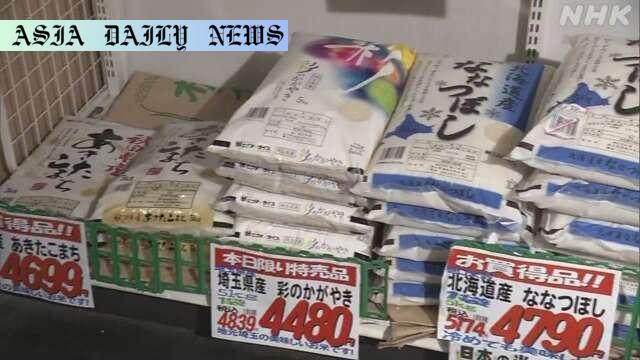Rice Prices face a massive drop in brand-name rice sales as supermarkets cut prices by 10% to combat falling demand.
- The Japanese government released cheaper rice to lower soaring grain prices.
- Sales of branded rice dropped by 30% as consumers opt for affordable alternatives.
- Supermarkets are cutting prices and scaling back orders to cope with low sales.

Impact of Government-Subsidized Rice on Brand-Name Varieties
The Japanese government’s intervention in stabilizing rice prices by releasing grains from national reserves has had a ripple effect on the marketplace. Consumers have eagerly embraced these more affordable rice options during tough economic times, as inflation continues to challenge household budgets. At a retail price of about 2,000 yen ($14) for a 5-kilogram bag, the government-provided rice is significantly cheaper when compared to branded alternatives, which often sell for around 5,000 yen ($34). While these measures are welcomed by the average consumer, their effects on the branded rice market have been profound and far-reaching.
Branded Rice in Decline: A 30% Drop in Sales
The impact on branded rice has been striking. In May, sales for premium, region-specific rice varieties at some local supermarkets plummeted by as much as 30%. Many Japanese households, which traditionally placed significant value on the origin and quality of their rice, have now turned to the cheaper government stockpile grains. This shift not only reflects changing consumer habits but poses a considerable challenge for retailers specializing in branded products. For instance, a Saitama-based supermarket has been forced to reduce prices by 10% to attract consumers back, even at the risk of incurring losses on their already premium-priced inventory.
Operational Strain on Supermarkets
The steep decline in branded rice sales has left supermarkets struggling to adapt. Unable to dispose of unsold rice easily, stores like Super Marusan are compelled to sell inventory at discounted rates. According to branch manager Yagi Yoshiki, smaller profit margins—or even losses—have now become a reality. Adding to this strain, supermarkets are scaling back their orders for branded rice as a way to realign costs and inventory needs. These adjustments, while necessary, highlight the precarious position retailers are in as they work to satisfy both government policies and consumer demands.
Broader Economic Implications
The situation underscores a larger economic trend in Japan, where inflationary pressures are reshaping consumer priorities. While government-subsidized rice serves as a short-term relief measure for households, it inadvertently undermines the premium rice industry’s stability. Farmers who rely on consumers’ willingness to pay a premium for branded varieties may face financial uncertainty as demand continues to drop. This challenge raises questions about how government interventions can better balance affordability for consumers and sustainability for traditional agricultural sectors.
A Need for Strategic Adaptation
As this complex situation unfolds, key stakeholders, including farmers, retailers, and the government, must work toward a sustainable solution. Farmers producing branded rice could benefit from increased marketing efforts that highlight the unique qualities of their product, from taste to regional significance. Retailers, meanwhile, may consider diversifying offerings or collaborating with local farmers to create more affordable but high-quality options. The government could also step in to ensure that its actions, while aiding consumers, do not inadvertently destabilize entire sectors of the economy.



Commentary
Striking a Balance Between Affordability and Quality
The ongoing battle over rice pricing in Japan brings into sharp focus an age-old economic dilemma: affordability versus quality. On one hand, the Japanese government’s decision to release stored rice at significantly lower prices comes as a relief to many consumers feeling the pinch of inflation. On the other hand, this policy inadvertently places an enormous strain on the market for premium, branded rice, shaking up traditional consumer preferences and threatening livelihoods.
Challenges for Branded Rice Farmers and Retailers
Farmers and retailers dealing in brand-name rice now face an uphill battle to compete with heavily subsidized government options. For decades, premium rice varieties have thrived due to the deep appreciation many Japanese consumers have for their region-specific qualities and flavor profiles. However, with a 30% decline in sales and supermarkets turning to price cuts to stay afloat, their future appears less secure. This shift brings to light pressing questions about how traditional industries can adapt to sudden economic pressures brought on by state interventions.
A Potential Path Forward
Despite the challenges, this scenario offers an opportunity for growth and innovation. Farmers, for example, might explore emphasizing the traceability and heritage of their rice through clever marketing strategies. These efforts could remind consumers of the intrinsic value of what they’re paying for. Meanwhile, supermarkets have a chance to pivot towards creating value offerings, such as curated bundles of premium rice with complementary items. By remaining agile, the industry might not only survive this storm but emerge stronger.
Final Thoughts
Ultimately, the current rice market situation in Japan is a reminder of how interconnected economic policies and consumer behavior are. While affordability is key during tough times, preserving the unique qualities of premium products like branded rice can help maintain cultural and economic balance. All stakeholders—government, businesses, and consumers—must act thoughtfully to ensure both immediate relief and long-term sustainability. The challenge lies in creating a win-win scenario that caters to affordability without undermining quality and tradition.